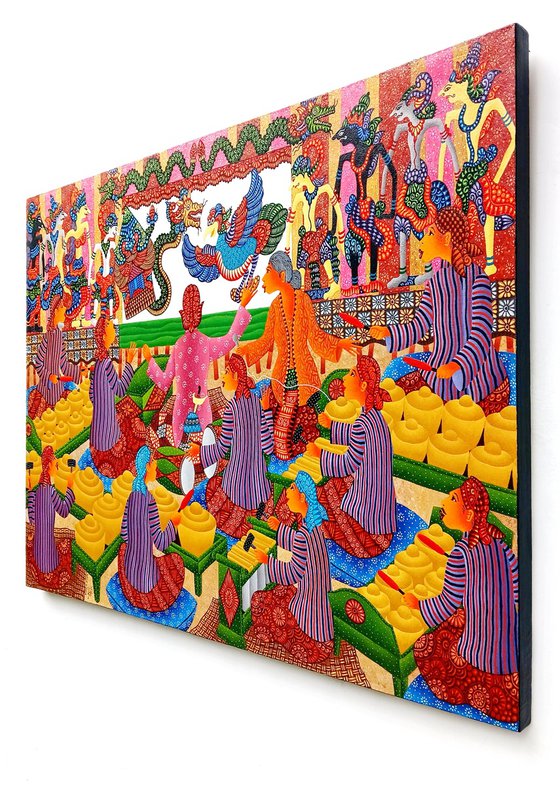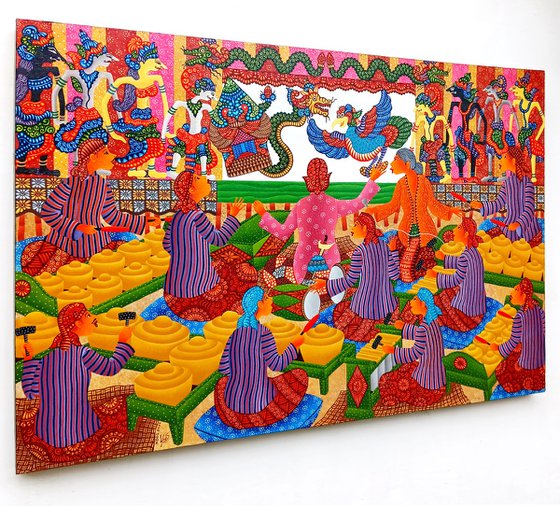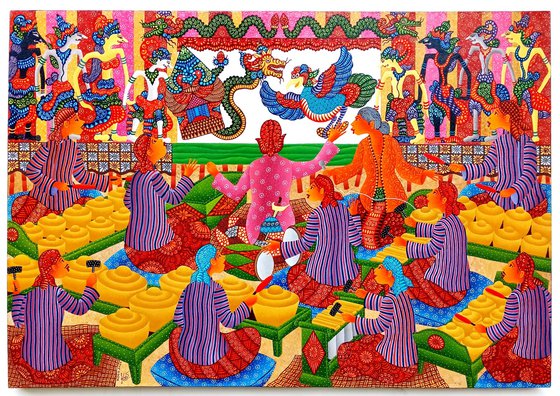Main Navigation
Original artwork description:
Wayang kulit is one of Indonesia's traditional art forms that has developed over centuries, particularly on the islands of Java and Bali. This art combines elements of drama, vocal art, music, visual art, and literature into a unique performance rich with philosophical meaning.
Origins and History
Influence of Local and Indian Culture
Wayang kulit is believed to have originated from local Nusantara (Indonesian archipelago) culture, later influenced by Indian culture, especially during the introduction of Hinduism and Buddhism to Indonesia around the 1st century AD. Stories in wayang such as the Ramayana and Mahabharata are literary legacies from India that were then adapted with local nuances.
The Hindu-Buddhist Kingdom Era
Wayang performances flourished during the time of major kingdoms such as the Medang Kamulan, Ancient Mataram, and Majapahit kingdoms. At that time, wayang served as a medium for religious preaching, education, and entertainment for both the common people and the nobility.
Transformation During the Islamic Period
When Islam spread to Java, wayang art did not disappear. In fact, the Wali Songo (nine Islamic saints), especially Sunan Kalijaga, used wayang as a tool for preaching. The form of wayang kulit was modified so it wouldn't resemble human figures (in accordance with Islamic prohibitions), and Islamic values were incorporated without eliminating the local cultural roots.
Function and Meaning
Wayang kulit is more than just entertainment. It conveys moral messages, spiritual teachings, and depicts the conflict between good and evil. Characters like the Pandawa and Kurawa reflect the complex and dilemma-filled nature of human beings, yet always oriented toward goodness.
Wayang Kulit Performances
Performances are usually held at night and can last until dawn. In a single show, the dalang (puppet master) performs all the characters with remarkable skill and fluidity. The dalang also serves as narrator, voices the characters, and controls the storyline, accompanied by a gamelan orchestra and sindhen (female vocalists).
Materials used:
acrylik on canvas
Tags:
#traditional art #patern unik #traditional patern #traditional painting #traditional culturulPAGELARAN WAYANG KULIT (2025) Acrylic painting
by Kus Budiyanto
£2,282.4
- Acrylic painting on Canvas
- One of a kind artwork
- Size: 150 x 100 x 3cm (unframed) / 150 x 100cm (actual image size)
- Ready to hang
- Signed on the front
- Style: Illustrative
- Subject: People and portraits
Loading
Original artwork description
Wayang kulit is one of Indonesia's traditional art forms that has developed over centuries, particularly on the islands of Java and Bali. This art combines elements of drama, vocal art, music, visual art, and literature into a unique performance rich with philosophical meaning.
Origins and History
Influence of Local and Indian Culture
Wayang kulit is believed to have originated from local Nusantara (Indonesian archipelago) culture, later influenced by Indian culture, especially during the introduction of Hinduism and Buddhism to Indonesia around the 1st century AD. Stories in wayang such as the Ramayana and Mahabharata are literary legacies from India that were then adapted with local nuances.
The Hindu-Buddhist Kingdom Era
Wayang performances flourished during the time of major kingdoms such as the Medang Kamulan, Ancient Mataram, and Majapahit kingdoms. At that time, wayang served as a medium for religious preaching, education, and entertainment for both the common people and the nobility.
Transformation During the Islamic Period
When Islam spread to Java, wayang art did not disappear. In fact, the Wali Songo (nine Islamic saints), especially Sunan Kalijaga, used wayang as a tool for preaching. The form of wayang kulit was modified so it wouldn't resemble human figures (in accordance with Islamic prohibitions), and Islamic values were incorporated without eliminating the local cultural roots.
Function and Meaning
Wayang kulit is more than just entertainment. It conveys moral messages, spiritual teachings, and depicts the conflict between good and evil. Characters like the Pandawa and Kurawa reflect the complex and dilemma-filled nature of human beings, yet always oriented toward goodness.
Wayang Kulit Performances
Performances are usually held at night and can last until dawn. In a single show, the dalang (puppet master) performs all the characters with remarkable skill and fluidity. The dalang also serves as narrator, voices the characters, and controls the storyline, accompanied by a gamelan orchestra and sindhen (female vocalists).
Materials used:
acrylik on canvas
Tags:
#traditional art #patern unik #traditional patern #traditional painting #traditional culturul14 day money back guaranteeLearn more



